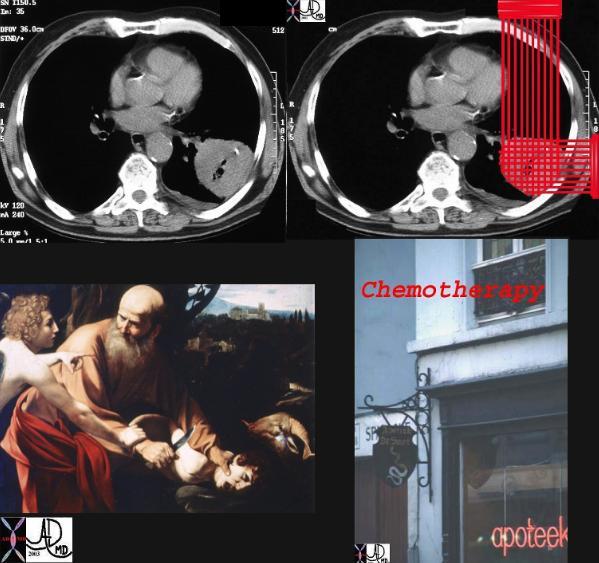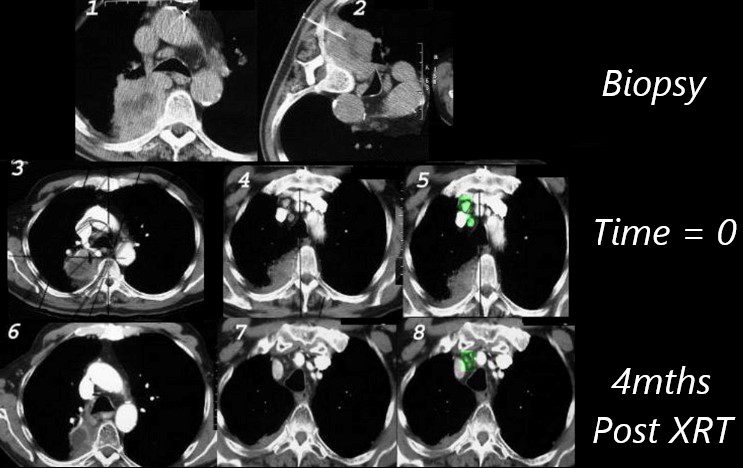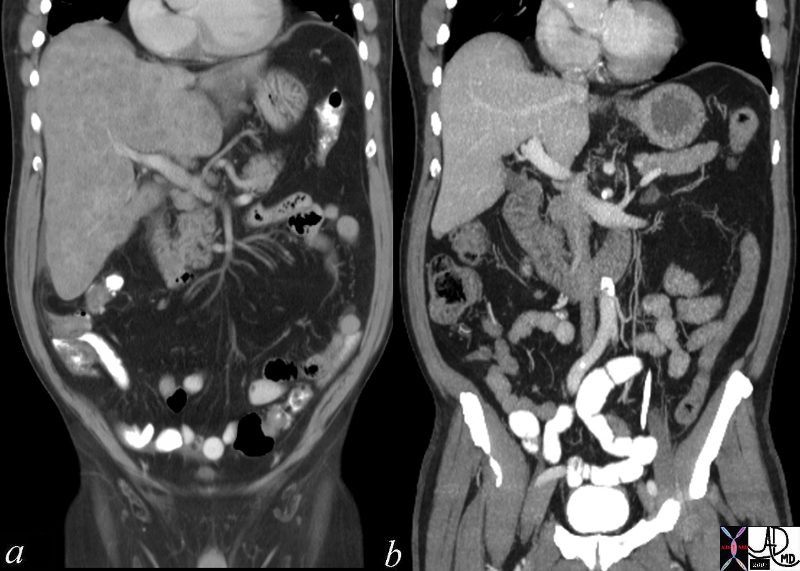Introduction
Surgery is required for cure. Surgical candidates include patients with stage I or II disease and in some patients who are stage IIIA. These categories account for 20-25% of patients. Intraoperative staging is accomplished by frozen section evaluation of mediastinal nodes

This is a collage of the usual treatments available for lung cancer. Top left depicts the XRT option while the Caravaggio of the sacrifice of Isaac is the surgical option and bottom right the chemotherapeutic option. (apoteek = pharmacy)
Courtesy Ashley Davidoff MD.
TheCommonVein.net
31432c
The treatment algorithm is based on the histological diagnosis. A tumor is classified as a small cell carcinoma or as one of the non-small cell varieties (squamous, adenocarcinoma, large cell carcinoma, bronchioloalveolar carcinoma. Staging of the carcinoma based on its anatomical extent, and functional evaluation of the patient are mandatory steps prior to therapeutic decisions.

This is a case of poorly differentiated non small cell carcinoma presenting as a large necrotic mass, with a percutaneous biopsy (2) treated with radiation therapy (3) with associated small nodes (4) overlaid in green (5) with a response as seen by shrinkage of the tumor 4 months later (6) as well shrinkage of the nodes (7,8)
Courtesy Ashley Davidoff MD.
TheCommonVein.net
32392cl03
Small Cell Carcinomas
By the time small cell carcinomas present metastatic disease is usual. (70%) Surgery therefore is unlikely to be curative, and the disease is treated with chemotherapy, occasionally augmented by radiotherapy. If clinical assessment and staging suggest localized disease (30%) surgical option should be considered.

The coronal reconstruction of the CT scan of a patient with small cell lung cancer metastatic to the liver before therapy (a) and 6 weeks after therapy. In image a the liver is riddled wit metastatic disease and in image b appears to be totally free of disease. Unfortunately this is the pattern of SCLC – but in general the disease recurs.
Courtesy Ashley Davidoff MD.
TheCommonVein.net
70248c01
Non Small Cell Carcinoma
At presentation, approximately one-third of patients are stage I,II,or IIa meaning they have disease localized enough for a curative attempt with surgery or radiotherapy. A further 30% have IIIA or IIIB with local or regional disease that has equivocal curative capability and the last 30% are stage IV meaning they have distant metastasis disease and are incurable.
Non-small cell cancers do not respond as well to chemotherapy as small cell cancers.
Surgery
Surgery is an absolute necessity in an attempt to cure the patient with XRT having fewer opportunities to accomplish cure. A lobe of a lung is usually removed but the whole lung can be removed if necessary.
Surgery is indicated for stages I or II and sometimes for III
Contraindications to surgery include;
systemic metastatic disease or lymphadenopathy beyond the ipsilateral hemithorax
malignant pleural effusion;
tumor within 2 cm of the carina
involvement of the main pulmonary artery.
superior vena cava syndrome;
vocal cord paralysis, phrenic nerve paralysis;
cardiac tamponade;
Radiotherapy
Radiotherapy is used as the main treatment for NSCLC and as a secondary treatment for small-cell carcinoma. Used alone in certain situations it sometimes has a chance to cure. For example a Stage I or II NSC carcinoma within 2cms of the carina cannot be treated surgically and is best treated and cured by XRT. Other situations where it is extremely helpful is in patients with bilateral endobronchial tumor and contralateral mediastinal node metastases, where XRT has an opportunity for cure and where surgery is contraindicated.
Chemotherapy
Chemotherapy is used as an additional treatment for NSCLC and the main treatment for SCLC

The heart has shifted into the left chest following pneumonectomy.
Courtesy Ashley Davidoff MD.
TheCommonVein.net
70192c01
